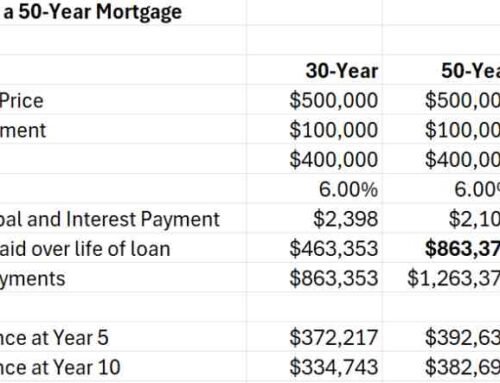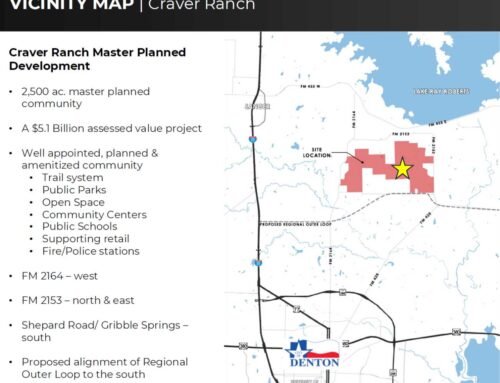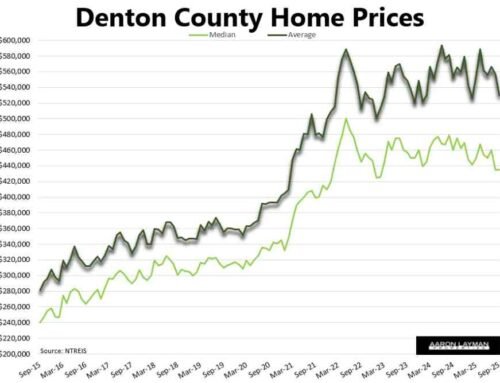The Denton County housing market correction continues to evolve. October home closings fell 22 percent year-over year. Pending sales were down by a similar amount. The housing market reset continues to take shape across North Texas as inflated home prices crumble under the weight of the Federal Reserve’s tightening cycle. Six and seven percent mortgage rates have proven to be too much for a housing market that ran up too far too fast during the pandemic.
Median home prices in Denton County continue to cool. Median home prices are down about $45,000 from the spring peak this year. Average prices are down $55,000 from the highs earlier in the year. While nominal prices actually rebounded slightly in October, the real price per square foot continued to fall. Buyers have been getting a little more home for their money as this housing reset takes shape. That’s probably welcome news for those shopping in the market.
Sellers continue to get hit with the Fed’s demand crush as lofty expectations of record spring prices fail to materialize. Median and average percent of list price are still falling off a cliff in North Texas. The median Denton County home sold for 97.3 percent of original list in October. The average fell to 96 percent of original list.
Days on market continue to spike with the recent demand crush. It’s now taking more than a month on average to sell a Denton County home. Good homes are still selling relatively quickly, but sellers are being punished for deferred maintenance or a lack of motivation. Phoning it in is no longer an acceptable marketing tactic. I am still seeing some delusional overpriced listings, but there is some normality finally returning to the market.
Available home inventory continues to rise. That’s something you wouldn’t typically see with normal seasonal patterns. Denton County stood at 2.6 months of inventory in October. New home supply is holding above five months as builders remain coy about lowering their inflated profit margins or the price of new homes in the area. The price cuts continue at the margins, but there has been no real capitulation yet by most builders.
Arlington-based D.R. Horton reported net income of $1.6 billion in its fiscal fourth quarter with a 6 percent rise in home closings. Horton’s net income was 22 percent higher than the same quarter a year ago. D.R. Horton was so flush with cash they repurchased $251 million in stock, bringing the total for share buybacks in fiscal 2022 to $1.1 billion. Nothing like a little financialization to pad executive compensation.
The coming months should bring a little more motivation from builders as contract cancellations continue to pile up. Greed has its limits, and buyers are finally stepping back from the market with affordability out of reach. D.R. Horton’s net sales orders for the fourth quarter fell 15 percent. Horton’s cancellation rate spiked to 32 percent in the fourth quarter. That would explain the spike in new construction listings the past few weeks and the price cuts on many new homes sitting on the market. There’s still a huge backlog of new construction set to hit the market in the first half of 2023.
D.R. Horton is just the latest builder to report a big spike in cancellations and collapsing home orders as falling demand weighs on the housing market. The reason is pretty simple. With mortgage rates still double where they were last year, home prices are still too expensive. Affordability has been crushed, and the monthly payments just don’t make sense for many prospective buyers.
October’s better than expected CPI inflation numbers showed year-over-year headline inflation at 7.7 percent. The shelter components for CPI posted the highest readings of the cycle. Lagged CPI indicators are finally beginning to cool, but the shelter and housing components of CPI will help to keep those readings elevated for months to come. The stock market and mortgage markets celebrated the relief on the inflation front, but there’s a long way to go before the Fed gets anywhere near their two percent inflation target.
The road ahead for the housing market will remain challenging because the demand destruction set in motion by the Fed will continue longer than many are anticipating. It’s important to remember that real quantitative tightening didn’t really start until September. We may only see a few more rate hikes from the Fed, but they have been pretty clear that they have no intention of lowering rates anytime soon. The Fed’s bloated balance sheet is only beginning to unwind. It will be another year or more before the Fed can say they have made any progress on this front.
Prospective buyers hoping for 4 or 5 percent mortgage rates anytime soon should temper their expectations. Higher for longer remains the theme in terms of rates. 6 percent rates are certainly better than 7, so buyers will likely take whatever relief the market provides. Carpe diem as they say.
The U.S. is currently sitting on a record number of housing units under construction. With the recent demand crush, the mix is beginning to shift toward more multi-family construction.


















Leave A Comment